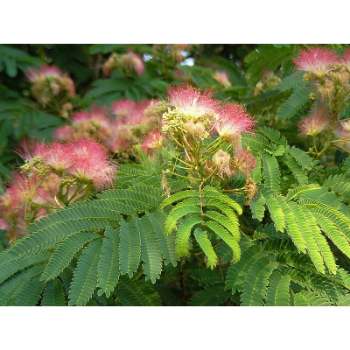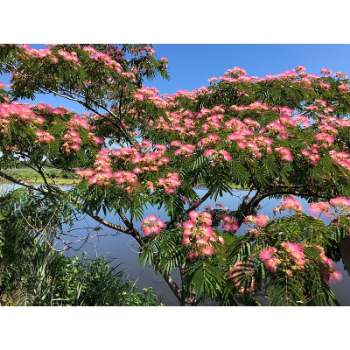Mimosa trees have several problems with them, like making a mess, being prone to Fusarium wilt disease, and spreading quickly, which can hurt the environment.
It’s important to balance these advantages with the many disadvantages related to mimosa trees, however. Their proclivity for messiness is one noticeable problem. Mimosa trees are infamous for scattering fallen blooms, seed pods, and sticky sap from their leaves across their surrounds. They become less desirable as landscaping options because of the inconvenience that this continuous cleaning may cause for homeowners and gardeners.
The sensitivity of mimosa trees to Fusarium wilt, a deadly disease that often results in the tree’s full mortality, is another serious issue. Early to midsummer is when the leaves of diseased mimosa trees begin to yellow and droop, ultimately causing the tree to die. Mimosa wilt, a disease that affects these trees, may be a major worry for anyone who want to grow them since it reduces their beauty and lifespan.
Beyond these obvious problems, mimosa trees’ invasiveness poses a menace to the ecosystem. They quickly expand, outcompeting local plant species for nutrients and sunshine. Mimosa trees also fix nitrogen in the soil, which modifies soil nutrient levels via their leaf litter. Even while certain plant species may gain, the native flora and the animals that depend on it may suffer as a result.
These challenges range from insect infestations to nutrient deficiencies and require proper care and attention. We will discuss the most common problems faced by Mimosa trees and offer effective solutions to keep them thriving. By understanding these issues and implementing the recommended solutions, you can ensure that your Mimosa tree remains healthy and adds beauty to your outdoor space.
Diseased mimosa tree Appearance
A diseased mimosa tree, affected by mimosa wilt, typically exhibits symptoms such as yellowed, stunted, and wilted leaves on one or several branches in early to mid-summer. The afflicted branches may prematurely defoliate later in the summer. Mimosa trees are seriously threatened by the Fusarium oxysporum-caused disease, which has to be quickly treated by removing and killing the affected trees.
Yellowed leaves on one or more tree branches are one of the early warning signs. These leaves often seem wilted and withered, showing a clear lack of vigor. Another concerning sign might appear as the summer goes on: the damaged branches can prematurely shed their leaves, adding to the tree’s overall suffering.
Fusarium oxysporum, a fungal infection, is the perpetrator behind the unpleasant symptoms of mimosa wilt. This disease is extremely hazardous to mimosa trees and has quickly spread across the Southeastern United States, drastically decreasing the value and lifetime of these magnificent landscaping plants.
The only way to stop mimosa wilt’s spread and rescue afflicted trees is to take action. It is important to act quickly to treat infected trees. The advised line of action is to cut down and remove the sick trees. It’s crucial to make sure that no fragments of the contaminated plant are left behind, such as chips or other debris, since they might possibly retain the virus and worsen the situation.
Also Read : Mimosa Tree – How to Keep It Small(Pruning Guide)

Disadvantages of mimosa plant
I must confess that the mimosa plant has a number of serious drawbacks that have broad ecological effects, despite its wonderful look. Here, I’ll go into further depth about these negative aspects:
- First and foremost, it is important to recognize that mimosa plants are invasive by nature. This indicates that they possess the amazing capacity to colonize and flourish in a variety of soil types, even ones that could be unfavorable to local flora. Because they outcompete native plants for resources and often result in a decrease in native biodiversity, their invasive tendencies represent a severe danger to local ecosystems.
- Rapid Multiplication: The mimosa plant’s quick rate of multiplication is another unsettling characteristic. These plants have a substantially faster rate of reproduction than many native species. They do this by generating a large number of seeds enclosed in long, brown pods that are still viable throughout the winter. New mimosa plants grow in previously unaffected places when these seeds are disseminated, whether naturally or as a result of human activity. This extensive distribution worsens their intrusive behavior.
- Suppression of Native Plant development: The suppression of native plant development is perhaps one of the invasion of mimosa’s most worrisome effects. The characteristic umbrella-shaped crown of the mimosa creates a thick canopy that effectively blocks sunlight from reaching the ground below. Native plants can’t fully photosynthesize and can’t grow well in this shadow. The displacement of native flora that results from this meddling over time might upset the delicate balance of the nearby ecosystems.

What to do If mimosa tree suddenly dying?
Fusarium wilt is a significant and worrisome potential among the many causes of a mimosa tree’s rapid demise. Fusarium oxysporum f. sp. perniciosum, a soil-borne fungus that typically enters trees via their root systems, is the culprit behind the fungal disease known as fusarium wilt. Although this fungus is often connected to tree wounds, it may potentially directly penetrate fragile trees.
Yellowing leaves that later wilt, become brown, and finally die are often the first indicators of Fusarium wilt. Twigs and branches may begin to brown and dieback as a consequence of this development, and in extreme circumstances, the whole tree may eventually perish. This fungus is one of the most deadly diseases that mimosa trees may get and is especially dangerous for them.
Environmental variables may also be a contributing element to your mimosa tree’s abrupt decrease in addition to Fusarium wilt. For instance, the tree may suffer harm from a protracted frost, leaving it with brown and withering limbs. Additionally, the health of the tree may suffer from too wet soil, particularly after a period of heavy rainfall.
Also to blame for the degeneration of the tree’s root system and consequent reduction in general health are root infections like phytophthora. In addition, physical harm from strong winds or deep snow may weaken the tree and lead to limb breaks, possibly worsening its health.
In these situations, it’s critical to evaluate the tree’s general health and look for any underlying problems. If there is still a chance for recovery, look for green, healthy tissue under the bark of little branches. To analyze the condition and choose the best course of action, an arborist or horticulturist may be required if Fusarium wilt is suspected since it may be a difficult disease to treat.
How to revive a dying mimosa?
Carefully monitoring the mimosa tree’s water and light requirements, as well as managing any possible diseases, are necessary to bring it back to life. The measures you may follow to restore your mimosa to health are as follows:
Proper Watering: Keeping a regular watering regimen is essential to save a mimosa that is starting to wilt. It’s time to water when the top quarter of the soil in the pot or garden bed dries up. To prevent startling the roots, use warm water. To avoid saturated soil, which may injure the roots and cause further decline, make sure that any extra water can drain away.
Avoid Pouring Cold Water: Never pour cold water straight over the soil as this may cause the roots to get stressed, which can lead to bloom loss and sluggish development. Water that is lukewarm is better for mimosa plants.
Consider Lighting: Consider the lighting for your mimosa. Make sure they get enough light since these plants need direct sunshine to grow. You can see leaves that have been impacted if your mimosa has been exposed to poor lighting. To promote healthy development, remove any broken leaves.
Management of Disease: Be on the lookout for disease indicators, such as drooping or yellowing leaves. Mimosa trees often get the disease fusarium wilt. Regular tree watering and timely removal of any unhealthy branches are the best ways to control or avoid it. Burn the infected branches to stop the illness from spreading. Additionally, using a balanced fertilizer helps lessen the risk of Fusarium wilt.
Think About Root Damage: If your mimosa tree has root damage, you may want to think about utilizing a rooting hormone such powdered Indole-3-butyric acid (IBA). If large chunks of the roots have been injured or nibbled off, this may promote root development and regeneration. To apply the product correctly, follow the manufacturer’s instructions.
Frequently Asked Questions For 7 Mimosa Tree Problems & Solutions
Why Should You Not Plant A Mimosa Tree In Your Yard?
Planting a Mimosa tree in your yard is not recommended due to its invasive nature.
What Is Wrong With My Mimosa Tree?
The problem with your Mimosa tree could be due to various factors such as pests, diseases, or improper care.
What Does A Diseased Mimosa Tree Look Like?
A diseased Mimosa tree typically exhibits yellow leaves, wilting branches, and cankers on the trunk.
What Is The Lifespan Of A Mimosa Tree?
The lifespan of a Mimosa tree typically ranges from 10 to 20 years.
Conclusion
Mimosa trees can undoubtedly add beauty to any landscape, but they also come with their fair share of problems. Fortunately, there are solutions available for each issue that may arise. By carefully monitoring and maintaining the tree’s health, yellowing leaves and mimosa webworm infestations can be prevented.
It is also important to address any potential issues with the tree’s root system, such as rot or damage from invasive roots. Regular pruning and removal of dead wood will help prevent the spread of diseases and pests. Lastly, taking precautions to avoid mimosa wilt disease, such as selecting disease-resistant varieties and providing proper irrigation, can ensure the tree’s longevity.
By following these solutions, you can enjoy the beauty of your mimosa tree without the worry of common problems. Remember, a little bit of care goes a long way in keeping your mimosa tree thriving for years to come.
